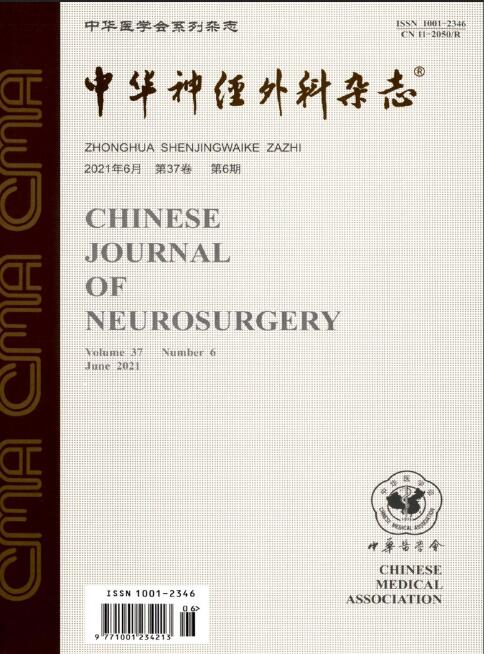Short-term efficacy analysis of STN-DBS for Parkinson′s disease in patients with low improvement rate in levodopa challenge test
Q4 Medicine
引用次数: 0
Abstract
Objective To investigate the short-term efficacy of STN-DBS (subthalamic nucleus-deep brain stimulation) in patients with Parkinson′s disease and an improvement rate of <30% in levodopa challenge test (LCT). Methods A retrospective analysis was conducted on the clinical data of 35 patients with Parkinson′s disease and an improvement rate of <30% in LCT who underwent STN-DBS from March 2015 to December 2017 at Department of Neurosurgery, Changhai Hospital Affiliated to Navy Medical University. All those patients were divided into tremor dominant (TD) type (n=12), postural instability/gait disturbance (PIGD) type (n=17) and indeterminate type (n=6) according to the motor symptoms of Parkinson′s disease. The preoperative LCT improvement rate and the improvement rate of motor symptoms in an on-stimulation off-medication state (referred to as the postoperative improvement rate of motor movement symptoms) were compared in 3 groups of patients. Comparison and analysis were conducted on the improvement rate of LCT before surgery and the improvement rate of motor symptoms at 1 month post STN-DBS. Results The improvement rates in LCT of TD, PIGD and indeterminate types of patients prior to operation were (19.38±6.85)%, (23.76±5.02)% and (16.48±10.00)% respectively. There was no statistical difference among the 3 groups (F=2.31, P=0.12). The postoperative improvement rates of motor symptoms in those 3 types were (51.75±8.65)%, (41.52±13.11)% and (38.90±14.15)% respectively. There was significant difference among the groups (F=3.39, P=0.04). The postoperative improvement rate of motor symptoms was significantly higher than the improvement rate in preoperative LCT in 35 patients (t=9.46, P<0.01) and in subgroup aualysis(P<0.01 respectively). The elevation from preoperative improvement rate in LCT to post-DBS improvement rate of motor symptoms in 3 groups of patients was statistically significant (F=4.12, P=0.03), and the difference between TD and PIGD types was statistically significant (P=0.02). Conclusion STN-DBS seems effective for improving the motor symptoms of Parkinson′s disease patients with LCT<30%, particularly in TD types in terms of short-term outcome. Key words: Parkinson disease; Tremor; Deep brain stimulation; Levodopa challenge test; Treatment outcomeSTN-DBS治疗左旋多巴激发试验改善率低的帕金森病患者的短期疗效分析
目的探讨丘脑底核深部脑刺激(STN-DBS)治疗帕金森病的近期疗效及左旋多巴激发试验(LCT)改善率<30%。方法对2015年3月至2017年12月在海军医科大学附属长海医院神经外科接受STN-DBS治疗的35例LCT改善率<30%的帕金森病患者的临床资料进行回顾性分析。根据帕金森病的运动症状,将所有患者分为震颤显性型(TD)(n=12)、姿势不稳定/步态障碍型(PIGD)(n=17)和不确定型(n=6)。比较3组患者的术前LCT改善率和在刺激-非药物状态下运动症状的改善率(称为运动运动症状的术后改善率)。比较分析术前LCT的改善率和STN-DBS后1个月运动症状的改善率。结果TD、PIGD和不确定型患者术前LCT的改善率分别为(19.38±6.85)%、(23.76±5.02)%和(16.48±10.00)%。三组患者术后运动症状改善率分别为(51.75±8.65)%、(41.52±13.11)%和(38.90±14.15)%。两组间有显著性差异(F=3.39,P=0.04)。35例患者术后运动症状改善率显著高于术前LCT改善率(t=9.46,P<0.01),亚组分析改善率(P<0.01)。3组患者的运动症状从术前LCT改善率提高到DBS后改善率具有统计学意义(F=4.12,P=0.03),TD型和PIGD型之间的差异具有统计学意义,特别是在短期结果方面的TD类型中。关键词:帕金森病;震颤;脑深部刺激;左旋多巴激发试验;治疗结果
本文章由计算机程序翻译,如有差异,请以英文原文为准。
求助全文
约1分钟内获得全文
求助全文
来源期刊

中华神经外科杂志
Medicine-Surgery
CiteScore
0.10
自引率
0.00%
发文量
10706
期刊介绍:
Chinese Journal of Neurosurgery is one of the series of journals organized by the Chinese Medical Association under the supervision of the China Association for Science and Technology. The journal is aimed at neurosurgeons and related researchers, and reports on the leading scientific research results and clinical experience in the field of neurosurgery, as well as the basic theoretical research closely related to neurosurgery.Chinese Journal of Neurosurgery has been included in many famous domestic search organizations, such as China Knowledge Resources Database, China Biomedical Journal Citation Database, Chinese Biomedical Journal Literature Database, China Science Citation Database, China Biomedical Literature Database, China Science and Technology Paper Citation Statistical Analysis Database, and China Science and Technology Journal Full Text Database, Wanfang Data Database of Medical Journals, etc.
 求助内容:
求助内容: 应助结果提醒方式:
应助结果提醒方式:


